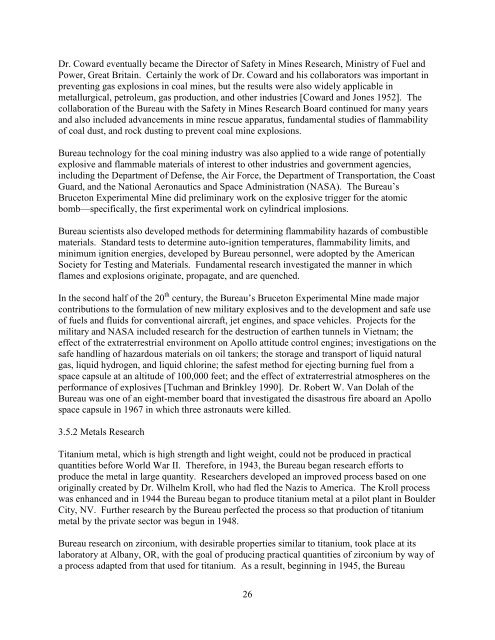One Hundred Years of Federal Mining Safety and Health Research
One Hundred Years of Federal Mining Safety and Health Research
One Hundred Years of Federal Mining Safety and Health Research
- No tags were found...
You also want an ePaper? Increase the reach of your titles
YUMPU automatically turns print PDFs into web optimized ePapers that Google loves.
Dr. Coward eventually became the Director <strong>of</strong> <strong>Safety</strong> in Mines <strong>Research</strong>, Ministry <strong>of</strong> Fuel <strong>and</strong><br />
Power, Great Britain. Certainly the work <strong>of</strong> Dr. Coward <strong>and</strong> his collaborators was important in<br />
preventing gas explosions in coal mines, but the results were also widely applicable in<br />
metallurgical, petroleum, gas production, <strong>and</strong> other industries [Coward <strong>and</strong> Jones 1952]. The<br />
collaboration <strong>of</strong> the Bureau with the <strong>Safety</strong> in Mines <strong>Research</strong> Board continued for many years<br />
<strong>and</strong> also included advancements in mine rescue apparatus, fundamental studies <strong>of</strong> flammability<br />
<strong>of</strong> coal dust, <strong>and</strong> rock dusting to prevent coal mine explosions.<br />
Bureau technology for the coal mining industry was also applied to a wide range <strong>of</strong> potentially<br />
explosive <strong>and</strong> flammable materials <strong>of</strong> interest to other industries <strong>and</strong> government agencies,<br />
including the Department <strong>of</strong> Defense, the Air Force, the Department <strong>of</strong> Transportation, the Coast<br />
Guard, <strong>and</strong> the National Aeronautics <strong>and</strong> Space Administration (NASA). The Bureau’s<br />
Bruceton Experimental Mine did preliminary work on the explosive trigger for the atomic<br />
bomb—specifically, the first experimental work on cylindrical implosions.<br />
Bureau scientists also developed methods for determining flammability hazards <strong>of</strong> combustible<br />
materials. St<strong>and</strong>ard tests to determine auto-ignition temperatures, flammability limits, <strong>and</strong><br />
minimum ignition energies, developed by Bureau personnel, were adopted by the American<br />
Society for Testing <strong>and</strong> Materials. Fundamental research investigated the manner in which<br />
flames <strong>and</strong> explosions originate, propagate, <strong>and</strong> are quenched.<br />
In the second half <strong>of</strong> the 20 th century, the Bureau’s Bruceton Experimental Mine made major<br />
contributions to the formulation <strong>of</strong> new military explosives <strong>and</strong> to the development <strong>and</strong> safe use<br />
<strong>of</strong> fuels <strong>and</strong> fluids for conventional aircraft, jet engines, <strong>and</strong> space vehicles. Projects for the<br />
military <strong>and</strong> NASA included research for the destruction <strong>of</strong> earthen tunnels in Vietnam; the<br />
effect <strong>of</strong> the extraterrestrial environment on Apollo attitude control engines; investigations on the<br />
safe h<strong>and</strong>ling <strong>of</strong> hazardous materials on oil tankers; the storage <strong>and</strong> transport <strong>of</strong> liquid natural<br />
gas, liquid hydrogen, <strong>and</strong> liquid chlorine; the safest method for ejecting burning fuel from a<br />
space capsule at an altitude <strong>of</strong> 100,000 feet; <strong>and</strong> the effect <strong>of</strong> extraterrestrial atmospheres on the<br />
performance <strong>of</strong> explosives [Tuchman <strong>and</strong> Brinkley 1990]. Dr. Robert W. Van Dolah <strong>of</strong> the<br />
Bureau was one <strong>of</strong> an eight-member board that investigated the disastrous fire aboard an Apollo<br />
space capsule in 1967 in which three astronauts were killed.<br />
3.5.2 Metals <strong>Research</strong><br />
Titanium metal, which is high strength <strong>and</strong> light weight, could not be produced in practical<br />
quantities before World War II. Therefore, in 1943, the Bureau began research efforts to<br />
produce the metal in large quantity. <strong>Research</strong>ers developed an improved process based on one<br />
originally created by Dr. Wilhelm Kroll, who had fled the Nazis to America. The Kroll process<br />
was enhanced <strong>and</strong> in 1944 the Bureau began to produce titanium metal at a pilot plant in Boulder<br />
City, NV. Further research by the Bureau perfected the process so that production <strong>of</strong> titanium<br />
metal by the private sector was begun in 1948.<br />
Bureau research on zirconium, with desirable properties similar to titanium, took place at its<br />
laboratory at Albany, OR, with the goal <strong>of</strong> producing practical quantities <strong>of</strong> zirconium by way <strong>of</strong><br />
a process adapted from that used for titanium. As a result, beginning in 1945, the Bureau<br />
26
















